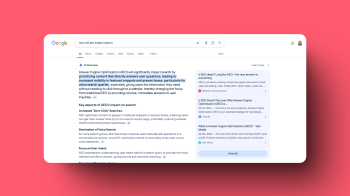
How to improve healthcare digital experiences with AEO and UX
Answer engine optimisation (AEO) is redefining how people find and interact with information online, and influencing the way digital experiences are designed.
We spoke with Tom Vaughton, CEO of Varn Health, to explore how AEO and UX can work together to enhance digital experiences in pharma and healthcare.

- SEO
- User Experience
- Digital Customer Experience
Answer engine optimisation (AEO) is transforming how people search for and access information online and reshaping the way digital experiences are designed. For healthcare organisations, aligning AEO with user experience (UX) ensures patients and healthcare professionals can find accurate, valuable information quickly and seamlessly.
We recently spoke with Tom Vaughton, CEO at specialist healthcare SEO agency, Varn Health, to explore how AEO and UX work together to improve healthcare digital experiences.
What is Answer Engine Optimisation (AEO) and how is it impacting search?
Answer Engine Optimisation (AEO) is the practice of optimising digital content to appear as direct answers in search results. Unlike traditional SEO, which focuses on ranking your website in a list of links, AEO targets the “zero-click” search results. These are typically the answers that people will see before they even think about clicking through to a linked website. So this means things like ‘featured snippets’, ‘rich results’, or the direct answers that will appear at the very top of the search page. AEO aims to satisfy the user’s need for an immediate, precise answer so you are able to find out the answer to your question, without clicking through to a website.
AI-powered search will be impacting how we search as the search engines like Google will evolve from being simply a tool to find information, to being engines that directly deliver answers. What this all means for anyone in healthcare marketing is that your content needs to be clear, concise and directly aligned with the specific queries and questions patients and HCPs will be asking. To stand out in the crowd, you will need to be ‘the answer’ people (and the search engines) are looking for.
How do you expect AEO to impact digital experiences within the healthcare and pharma sectors?
In healthcare and pharma, AEO will enable users to quickly access the most relevant, trustworthy information, directly from search results. This has huge implications for both patients and healthcare professionals who rely on accurate, timely data. For example, conditions, treatments, medications, or even side effects may appear as a clear, concise answer, enhancing the user experience by reducing the effort required to find and discover information.
AEO and UX intersect here because ensuring the right answers are delivered in the right way, demands not only SEO expertise but also deep understanding of user intent. Clear navigation, readable content and design that promotes accessibility will be crucial in providing a seamless experience alongside optimised content.
Ed Hart, Head of Design at Graphite, added:
AEO has the potential to fundamentally improve healthcare experiences by delivering accurate, relevant information directly to users. However, its success hinges on how well this integrates with the broader user journey.
AEO and UX must work hand-in-hand to not only surface the right answers but guide users seamlessly to explore deeper content. This involves designing intuitive navigation, clear call-to-action elements, and contextual pathways that allow both patients and professionals to find the information they need quickly and confidently
What does AEO mean for the way that digital content is created and structured?
AEO will be creating a shift towards much more structured and purposeful content creation. It means you must consider how your content is not only informative but also how it can be interpreted by search engines to provide the most accurate, succinct answers. This involves using more structured data, like schema markup, and organising content into clear sections that answer specific queries.
My question to you is, do you know your audience’s most common questions? This is because you need to create content that directly matches user intent and can be easily surfaced by AI-powered search engines in response to those specific questions.
What practical steps can healthcare teams take to align their content structure with both user needs and search visibility?
My suggestion is for healthcare teams to start by focusing on the following practical steps:
- 1 Conduct intent research: Identify the key questions your audience are asking and map these to your content. You can use helpful tools like Google’s ‘People Also Ask’ or ‘Answer the Public’ to reveal questions your audience is asking.
- 2 Use structured data: Get your SEO team to implement schema markup and other formats to help search engines understand your content’s context and relevance.
- 3 Prioritise clarity: Present answers in a straightforward, user-friendly manner. Bullet points, concise paragraphs and summarised information work well.
- 4 Focus on long-tail keywords: These often reflect specific questions or issues that people need immediate answers to.
- 5 Optimise for Retrieval Augmented Generation (RAG): Structure content in a way that supports RAG models. These models combine a user’s query with relevant data from external sources to generate tailored answers. To align with RAG, ensure your content is highly specific, factual and well-organised. Use robust internal linking, clear headings and structured metadata to make it easy for AI to retrieve and synthesise your information accurately.
- 6 Test and iterate: Regularly assess content performance and user engagement to fine-tune for both visibility and user satisfaction.”
Why is understanding and answering user intent critical for healthcare brands looking to deliver better digital experiences?
User intent is the foundation of any effective digital experience. In healthcare, the stakes are high – people often search for answers to urgent or sensitive issues, and if their needs aren’t met quickly and accurately, they may look elsewhere. By understanding and answering user intent, healthcare brands can ensure that they are not just providing information but delivering the solutions or answers that users are seeking. This leads to better engagement, increased trust and ultimately, a more positive experience.
Ed Hart, Head of Design at Graphite, added:
AEO’s emphasis on user intent aligns closely with UX’s focus on creating meaningful and personalised experiences. For the healthcare and pharma sectors, this means designing interfaces that cater to diverse audiences—whether a patient seeking reassurance or a clinician needing detailed data—while maintaining clarity and accessibility.
Furthermore, inclusive design principles, such as ensuring content is readable and accessible for all users, play a critical role in meeting regulatory requirements and fostering trust. By aligning AEO strategies with user-centred design, healthcare brands can deliver experiences that are both efficient and empathetic

How can organisations strike the right balance between providing detailed, compliant content and concise, user-friendly answers?
I would say that the key here is clarity. Organisations should aim to structure their content so that it offers detailed, compliant information in a way that’s easily understood and digestible. Use summary boxes, bulleted lists and “accordion” FAQ styles to offer both depth and brevity of answers. Ensure that detailed information is easy to find for those who need it, while also creating a clear, concise version for users who are looking for quick answers. This approach satisfies both user needs and regulatory requirements. I would also suggest running regular content audits as this will help you to ensure compliance, while maintaining up to date and user-friendly content.
Ed added:
While structuring content for compliance and user-friendliness is critical, we’d also emphasise the role of design in making this balance seamless and intuitive. Beyond techniques like expandable sections and summary boxes, the user journey must guide different audiences—patients, caregivers, or healthcare professionals—to the right level of detail at the right time. For instance, design can prioritise context-sensitive pathways that adapt to whether a user is researching symptoms or exploring real-world data.
How does AEO support optimisation for voice search?
AEO focuses on answering direct questions, which aligns perfectly with the type of content voice assistants are designed to pull from. By optimising for AEO, healthcare brands can increase the chances of their content being chosen as the voice assistant’s response, ensuring for example that when someone asks, “What are the side effects of x medication?” the answer provided is clear, accurate and sourced from their content.
Trust is non-negotiable in healthcare. How does AEO help build credibility, and what role does UX play in this?
AEO helps build trust by ensuring that content is directly answering users’ questions in a reliable, authoritative manner. Search engines like Google prioritise content from trusted, credible sources and AEO ensures that healthcare content ranks well in these trusted positions. However, trust isn’t just about ranking – it’s also about the user experience. A clean, accessible, and transparent website design, with user-friendly features, enhances credibility. Clear, concise answers, all backed by data and relevant sources, will also improve user confidence in the information provided.
Ed added:
Building trust in healthcare goes beyond accurate content—it requires consistent and reliable brand experiences. For example, maintaining a unified visual identity, tone of voice, and user interactions across all platforms.
Consistent branding, paired with intuitive navigation and accessible design, ensures users feel confident and supported every time they engage with your digital channels. When combined with AEO’s ability to deliver credible content, these cohesive experiences strengthen brand trust and user loyalty.
What trends or innovations do you see shaping the future of AEO and UX in healthcare? What’s on the cards for the months or years ahead?
The future of AEO and UX in healthcare will likely be shaped by advancements in AI, machine learning and even more sophisticated personalisation, voice and image search. As AI continues to evolve, healthcare organisations will need to optimise for even more nuanced user queries, tailoring content to meet complex and changing user needs. At the moment we know that AI can make mistakes, and answers aren't completely accurate all the time, but it's vital to acknowledge it’s improving at pace all the time, it’s not going away, so you really can't ignore it.
I think we will see stronger integration of UX design principles with AI-powered search engines, where the user journey is not just about getting an answer but having an engaging, efficient and highly personalised experience. This convergence of AEO and UX will make digital health content more intuitive, accessible and ultimately more aligned with the diverse needs of users. The months and years ahead will focus on refining this balance.
I also think healthcare brands will invest in interactive features and AI-enhanced content creation to better engage users, particularly as telehealth and virtual care continue to rise. As search engines evolve, healthcare organisations will need to stay agile, continuously adapting content to algorithm changes and user expectations to deliver seamless, user-centric digital experiences.
Thank you to Tom Vaughton, from Varn Health, for sharing his insights on how AEO is transforming search and digital experience.
5 key takeaways
- 1 AEO has the potential to improve healthcare experiences by delivering quick, accurate answers and aligning with user intent.
- 2 Clear, structured content is essential to meet user needs and balance compliance with usability.
- 3 AEO builds trust through credible content and intuitive, accessible design.
- 4 AI and voice search are shaping the future, requiring brands to adapt to advanced technologies.
- 5 Continuous improvement is key to staying relevant and delivering user-centric digital experiences.
Drive meaningful digital engagement in 2025
Graphite Digital and Varn Health partner with leading healthcare and organisations to create more impactful and visible digital experiences.
Looking to partner with specialised digital agencies who can help you drive engagement?
Read more on digital experience trends


5 digital trends transforming pharma and healthcare in 2025
- Healthcare
- Pharmaceutical

European Accessibility Act 2025: what's changing and what does it mean for you?
- Design
- Customer Experience